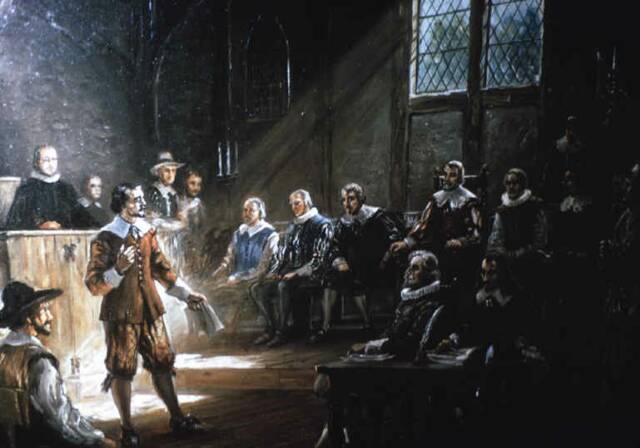Session: 
 Fall 2010
Fall 2010
Course Title: The Birth of Virginia’s Aristocracy
The Birth of Virginia’s Aristocracy
Instructor:  J. C. Thompson
J. C. Thompson
James Thompson holds undergraduate and graduate degrees in Philosophy from the University of Virginia. His interest in American history developed as a graduate student living on the Shadwell, Virginia farm of Thomas Jefferson’s daughter, Martha Jefferson Randolph. James completed the research for The Birth of Virginia’s Aristocracy as a Batten Fellow at the International Center for Jefferson Studies at Monticello in 2005.
Instructor Contact:
Day:
 703-407-3719
703-407-3719
Night:
 540-832-7859
540-832-7859
Email:
 jct@commonwealthbook.org
jct@commonwealthbook.org
I. Course Description:
Course Description:
This lecture series explains how the first civil society formed in Virginia, what purposes it served, who its members were, and what happened to it as it aged. It begins by recounting the difficulties Virginia’s first adventurers had founding the colony and how these problems were overcome when policies endorsed by Sir Edwin Sandys were implemented in 1619. This review reveals that civil society did not form in Virginia until the meeting of its first general assembly in the summer of that year. Attention then shifts to the oligarchy that developed during the 1st Royal Commonwealth Period (1624-1652), how this oligarchy solidified during the eight year interregnum which preceded the Restoration of 1660 and how it became an “inner circle” upon the return of imperious Governor William Berkeley in 1661. The series concluded with a discussion of Richard Lee II’s decision to summit to Thomas Lord Fairfax and how his peers ennobled themselves and completed the birth of Virginia’s aristocracy in the first years of the new century by following Lee’s example and recognizing the Fairfax family as their liege lords.
II.  Course Text:
Course Text:
Thompson, James: The Birth of Virginia’s Aristocracy. Commonwealth Books (2009)
III.  Other Books of Interest
Other Books of Interest
Beverly, Robert. The History and Present State of Virginia. Charlottesville: University Press of Virginia, 1947.
Billings, Warren M. Sir William Berkeley and the Forging of Colonial Virginia. Baton Rouge: Louisiana State University Press, 1965
Washburn, Wilcomb. Virginia under Charles I and Cromwell, 1625-1660. The Virginia 350th Anniversary Celebration Corporation, Williamsburg, VA, 1957.
Wertenbaker, Thomas J. Bacon’s Rebellion, 1676. The Virginia, 350th Anniversary Celebration Corporation. Williamsburg, VA; 1957.
IV. Teaching Method
Teaching Method
Class narrations will refer to the text and be supported with colorful power-point slides that illustrate the events and people discussed in his narrative. Class time will be reserved for discussion of text and lecture materials.
V. Class Content
Class Content
I. Colonial Connections (66 slides - 50 minutes)
Colonial Connections (66 slides - 50 minutes)
Part 1:
This segment reveals the forgotten connections that linked the men who organized and financed the colonial movement in
England. It remembers that they connected during the war that
Queen Elizabeth sustained through the last half of her reign to counter the expansion of Spain’s global empire and that they turned their swashbuckling energies to colonization and commerce after King James I made peace with Spain in 1604.The time period covered in this presentation extends from 1585 to 1606.
Part II:
This segment reveals the forgotten connections between the adventurers in London who directed the colonial enterprise in London and the men they selected to implement their plan in Virginia.
Reading: The Birth of Virginia’s Aristocracy, pages 1-10.
2.  From Commune to Commonwealth: 1603 - 1625
From Commune to Commonwealth: 1603 - 1625
Part I: 1603 - 1609 (36 Slides - 34 minutes)
1603 - 1609 (36 Slides - 34 minutes)
This segment remembers how these men came to form the Virginia Company and why King James gave them title to Sir Walter Raleigh’s vacant new world lands. It explains the form of the company under its first charter and how conflicts of interests divided the King of England, who sat as the nominal “chairman” of its board from the administrators of the colony whose creation he authorized. It remembers the financial difficulties that led to the re-chartering of the enterprise as a “joint stock company” in 1609 and summarizes Sir Thomas Smyth’s plan to salvage its failing colony. The time period covered in this presentation extends from 1603 to 1609.
Part II: 1609 - 1625 (36 Slides - 34 minutes)
1609 - 1625 (36 Slides - 34 minutes)
This segment remembers that social and organizational divisions undermined the unity of the colony’s first settlers and recounts the problems they encountered establishing a colony in Virginia. It considers the progress the colonists made after the implementation of Sir Thomas Smyth’s new regime. It recounts how the administration of the company changed in 1619 and that under the leadership of its new Treasurer, Sir Edwin Sandys, the company adopted a policy of private landownership and instituted a colonial legislature. It explains then that these innovations were instrumental in the transformation of the colony from a commune to a “commonwealth”. The time period covered in this presentation extends from 1609 to 1625.
Reading: The Birth of Virginia’s Aristocracy, pages 10-52.
3. The Will of the Colonists (24 Slides - 29 minutes)
The Will of the Colonists (24 Slides - 29 minutes)
This segment explains that, following Sir Edwin Sandys new program, the colony’s first legislature was established in 1619. It explains that the members of this legislature formed the colony’s first “civil society” and that this social organism contained only the superintendents the Virginia Company had appointed to manage its new world business and the headmen of the colony’s plantations. It remembers that Charles I abolished the general assembly in 1625 to keep it from obstructing his self-serving plans for the colony and that, because his colonial governors could not administer the colony with cooperation from its leading men, he re-opened the legislature in 1642. It remembers that the colony’s oligarchs and its new governor, Sir William Berkeley, then busied themselves advancing their own self-serving interests as foreign demand for Virginia’s tobacco expanded during the 1640’s. It closes by remembering that these were the
years of the English Civil War and that its parliamentarian victors beheaded King Charles I on 30 January 1649. The period covered in this presentation extends from 1619 to 1652.
Reading: The Birth of Virginia’s Aristocracy, pages 52-70.
4. The Northern Neck of Virginia (65 Slides - 35 minutes)
The Northern Neck of Virginia (65 Slides - 35 minutes)
This program remembers that Charles I lost his kingdom at the Battle of Naseby on 14 June 1645. It recounts the harrowing escape of his son and heir, Prince Charles, after his father’s defeat. It remembers that Charles was crowned King of England in Edinburg Scotland a week after his father’s execution and that soon thereafter he made a grant of land to seven of his loyal support: four lords who aided his escape from parliamentarian England and three knights who served him in the failed uprising of 1648. It recounts who these men were, what became of them and what became of their proprietary grant on the Northern Neck of Virginia during the interregnum and the first years of Charles II’s reign. The time period covered in this presentation extends from 1645 to 1662.
Reading: The Birth of Virginia’s Aristocracy, none.
5. Conflict of Interests (61 Slides - 49 minutes)
Conflict of Interests (61 Slides - 49 minutes)
Part I:
This segment remembers the divided loyalties of Charles II’s inner circle and how James, Duke of York, used his allies in the king’s council to channel the wealth of his brother’s new world dominions into his own pocket.
Part II:
This segment remembers that while the Lords of London were laying plans to harvest the wealth of the King’s New World provinces, the covetous governor of Virginia was creating his own establishment in Virginia. It remembers that Nathaniel Bacon led a rebellion against these competing adventurers in the name of people and that although his rebellion was ultimately unsuccessful,, Bacon did manage to wreck William Berkeley’s plan and cause King Charles to replace Sir William with an equally notorious scoundrel - Thomas, 2nd Lord Culpeper. The time period covered in this presentation extends from 1660 to 1677.
Reading: The Birth of Virginia’s Aristocracy, pages 70-100.
6. The Scholar’s Composition (66 Slides - 29 minutes)
The Scholar’s Composition (66 Slides - 29 minutes)
This program introduces Colonel Richard Lee II into Virginia‘s social history. It remembers Thomas, 5th Lord Fairfax and how he came to possess the Northern Neck Proprietary. It describes the circumstances in which Colonel Lee made his puzzling submission to Lord Fairfax and his descendents. It weighs the factors that influenced Lee’s deliberation, acknowledges Lee’s decision to submit to the Fairfaxes and explains the significance of his transfer of allegiance from his fragmented community to a distant member of England's feudal hierarchy. It observes that by following Lee and incorporating themselves into England’s hierarchical social system, the oligarchs of the “Old Dominion” completed the birth of Virginia’s Aristocracy. The time period covered in this program extends from 1670 to 1700.
Reading: The Birth of Virginia’s Aristocracy, pages 101-126.





